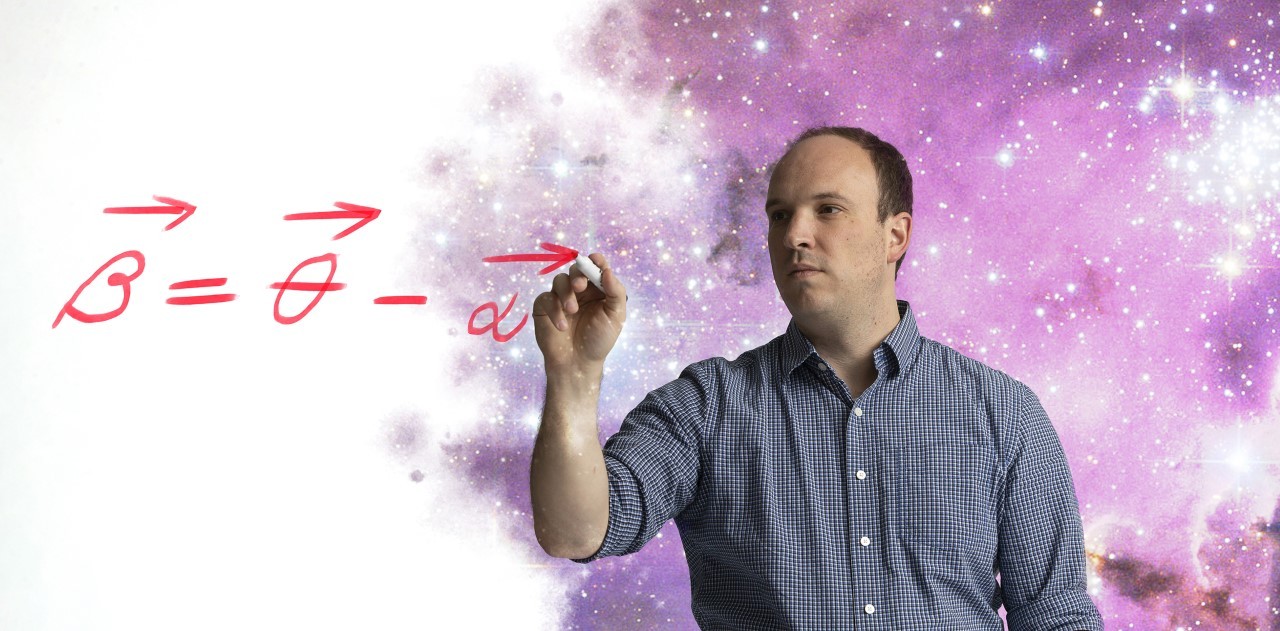
UC physicist turns galaxies into magnifying lens
Matthew Bayliss is applying a new technique to the study of massive, distant stars that burn hot, die young
University of Cincinnati physicist Matthew Bayliss used a massive cluster of galaxies like a natural cosmic telescope to get our best glimpse yet of short-lived stars.
The research provides a new way to study distant, supermassive stars that burn hot and bright but die in a blink compared to our own sun.
“These high-mass stars don’t live very long. They go off like fireworks for just tens of millions of years. Finding them is a lot of work,” he said.

UC assistant professor Matthew Bayliss studied distant stars by turning distant galaxies into a magnifying glass to record their X-rays. Photo/Lisa Ventre/UC Creative Services
The study was published in the journal Nature Astronomy.
Bayliss, an assistant professor in UC’s McMicken College of Arts and Sciences, collaborated with an international team of researchers in his former position at the Massachusetts Institute of Technology. The team used the famous Hubble space telescope for optical images along with the Spitzer space telescope, which provides infrared imaging. But arguably the most important tool was the Chandra X-ray Observatory, which captures X-rays from black holes and distant stars.
Unlike light from distant stars, X-rays don’t penetrate Earth’s atmosphere. So NASA in 1999 launched Chandra high above the Earth. How high? The International Space Station, which you can see at night with the naked eye, circles about 240 miles above the Earth. Chandra flies in an elliptical orbit as far as 86,500 miles away from Earth.
It's as if the universe placed a magnifying lens in space.
Matthew Bayliss, UC physicist explaining 'gravitational lensing'
To record X-rays from such distant sources, Bayliss used a phenomenon called gravitational lensing, which magnifies the star’s observable electromagnetic radiation. Albert Einstein predicted the effects of gravitational lensing in his theory of general relativity and even described how gravity could warp light and other energy.

Illustration of NASA's Chandra X-ray Observatory. Graphic/TRW
“It’s as if the universe placed a magnifying lens in space,” Bayliss said. “We can take our best telescopes and point them at these natural gravitational lenses, which amplify the power of our telescopes. You can see more distant things and more faint things than you otherwise would.”
The study marked the first use of gravitational lensing to observe distant stars through X-ray detection. But Bayliss said the tool could reveal the secrets of other supermassive stars, which are difficult to study because of how short-lived and distant they are.
“If you think of 50,000 people of all ages in a stadium, the odds of finding a 4-month-old baby are pretty small because babies aren’t 4-months-old for very long,” Bayliss said. “If you were studying middle-aged people, you’d get lots of data. But you wouldn’t have many babies to work with.
“The fraction of a lifetime that a human is a toddler is tiny in the same way that the fraction of the history of a galaxy that contains supermassive stars is tiny,” Bayliss said.

UC physicist Matthew Bayliss. Photo/Lisa Ventre/UC Creative Services
University of Michigan associate professor Keren Sharon, a co-author of the study, said gravitational lensing allows researchers to study galaxies that would be too faint to observe otherwise.
“We've been taking advantage of ‘cosmic telescopes’ to study faint galaxies in long wavelengths for a couple of decades now,” she said.
“Being able to observe them in the X-ray regime opens a window for new discoveries and enables detailed studies of intrinsically faint X-ray sources that would otherwise have to wait for the next generation of telescopes.”
Massive dying stars eventually collapse, ejecting their matter in a supernova explosion before becoming neutron stars or black holes. Despite vast improvements in astronomical observation, comparatively little is known about the origins of these massive stars and how they might influence each other, Bayliss said.
“We’re hoping to understand how young stars form in the distant universe,” he said.
Featured image at top: UC physicist Matthew Bayliss explains gravitational lensing with an equation. Photo illustration/Lisa Ventre and Margaret Weiner/UC Creative Services
Bayliss' research in the news
Cosmos Magazine: A weakened black hole allows its galaxy to awaken
Boston Globe: MIT researchers use galaxy cluster as magnifying glass to see faraway system in a new light
Independent: Astronomers use huge cluster of galaxies to 'peer back in time'
International Business Times: Astronomers Use Galaxy Cluster to See 9 Billion Years into the Past
Next Lives Here
The University of Cincinnati is classified as a Research 1 institution by the Carnegie Commission and is ranked in the National Science Foundation's Top-35 public research universities. UC's graduate students and faculty investigate problems and innovate solutions with real-world impact. Next Lives Here.
Become a Bearcat
- Apply online or get more information about undergraduate enrollment by calling 513-556-1100.
- Learn more about UC's many undergraduate and graduate programs.
Related Stories
Study finds police officers face higher long-term health risks
January 2, 2026
J.C. Barnes, a University of Cincinnati professor, is interviewed by Spectrum News about new research showing that the physical and psychological demands of law enforcement can contribute to earlier deaths.
Fusion reactors may be key to uncovering dark matter
December 22, 2025
Yahoo! News highlights a new study by University of Cincinnati physicist Jure Zupan that explains how fusion reactors might create subatomic particles associated with dark matter.
UC public relations course reaches vulnerable community
December 19, 2025
Rather than having students find opportunities for real world applications of their degrees beyond class, why not bring it to them in the classroom? The public relations campaigns class, offered through the communications department in UC’s College of Arts and Sciences, gives students a taste of experience in the field.
